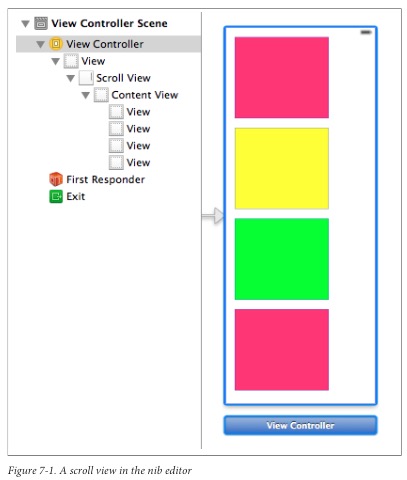设置UIScrollView的contentSize
如果使用自动布局,那么它会自动帮你基于这个scrollview的子视图的约束来计算这个内容大小。在非自动布局情况下,如果app旋转导致scrollview 的bounds改变,不会影响到scrollview的contentSize,而如果重新设置contentSize,也不会影响scrollview的子视图,这个contentSize仅仅是决定了滚动的范围。
下面我们用代码创建一个UIScrollView,UILabel在y轴上顺序排列:

UIScrollView* sv = [UIScrollView new];
sv.backgroundColor = [UIColor whiteColor];
sv.translatesAutoresizingMaskIntoConstraints = NO;
[self.view addSubview:sv];
[self.view addConstraints:
[NSLayoutConstraint constraintsWithVisualFormat:@"H:|[sv]|"
options:0 metrics:nil
views:@{@"sv":sv}]];
[self.view addConstraints:
[NSLayoutConstraint constraintsWithVisualFormat:@"V:|[sv]|"
options:0 metrics:nil
views:@{@"sv":sv}]];
UILabel* previousLab = nil;
for (int i=0; i<30; i++) {
UILabel* lab = [UILabel new];
lab.translatesAutoresizingMaskIntoConstraints = NO;
lab.text = [NSString stringWithFormat:@"This is label %d", i+1];
[sv addSubview:lab];
[sv addConstraints:
[NSLayoutConstraint constraintsWithVisualFormat:@"H:|-(10)-[lab]"
options:0 metrics:nil
views:@{@"lab":lab}]];
if (!previousLab) { // first one, pin to top
[sv addConstraints:
[NSLayoutConstraint constraintsWithVisualFormat:@"V:|-(10)-[lab]"
options:0 metrics:nil
views:@{@"lab":lab}]];
} else { // all others, pin to previous
[sv addConstraints:
[NSLayoutConstraint
constraintsWithVisualFormat:@"V:[prev]-(10)-[lab]"
options:0 metrics:nil
views:@{@"lab":lab, @"prev":previousLab}]];
}
previousLab = lab;
}
运行代码,你会发现label 都放置在正确的位置,但是scrollView 却不能滚动。而且,即使你手动设置了contentSize也无法滚动。原因就是在页面布局时,scrollview的contentSize会自动根据它和子视图之间的约束来计算得出。解决方法就是,再添加多一个约束,告诉scroll view 它的contentSize的高度应该是多少:
// 给底部最后一个label设置一个y轴方向的约束,这样高度就可以确定了
[sv addConstraints:
[NSLayoutConstraint constraintsWithVisualFormat:@"V:[lab]-(10)-|"
options:0 metrics:nil
views:@{@"lab":previousLab}]];
可以看到,我们可以在垂直方向上滚动scrollview了,在水平方向上仍然不能滚动(contentSize的宽度默认就是0,正好是我们需要的)。
使用一个Content View
我们一般不会把scrollview 的子视图直接添加到scrollview上,而是添加到UIView上,然后把这个视图再添加到scrollview上,这个视图就是这个Content View。这样可以更加方便的组织和使用。
在自动布局下,我们可以有两种设置scroll view的contentSize 方法:
-
设置content view 的translatesAutoresizingMaskIntoConstraints为YES,然后手动设置这个scroll view的 contentSize为这个content view的大小。
-
设置content view 的translatesAutoresizingMaskIntoConstraints为NO,然后给这个content view 设置宽度和高度约束。
设置content view的大小或者约束这种方式是与它的子视图怎么定位(设置frame,还是实用约束)无关。有四种可能的组合,这四种组合开头的代码都是一样的:
UIScrollView* sv = [UIScrollView new];
sv.backgroundColor = [UIColor whiteColor];
sv.translatesAutoresizingMaskIntoConstraints = NO;
[self.view addSubview:sv];
[self.view addConstraints:
[NSLayoutConstraint constraintsWithVisualFormat:@"H:|[sv]|"
options:0 metrics:nil
views:@{@"sv":sv}]];
[self.view addConstraints:
[NSLayoutConstraint constraintsWithVisualFormat:@"V:|[sv]|"
options:0 metrics:nil
views:@{@"sv":sv}]];
UIView* v = [UIView new]; // content view
[sv addSubview: v];
第一种组合不使用约束:
CGFloat y = 10;
for (int i=0; i<30; i++) {
UILabel* lab = [UILabel new];
lab.text = [NSString stringWithFormat:@"This is label %d", i+1];
[lab sizeToFit];
CGRect f = lab.frame;
f.origin = CGPointMake(10,y);
lab.frame = f;
[v addSubview:lab]; // add to content view, not scroll view
y += lab.bounds.size.height + 10;
}
// set content view frame and content size explicitly
v.frame = CGRectMake(0,0,0,y);
sv.contentSize = v.frame.size;
第二种组合,content view使用约束,但它的子视图不使用:
CGFloat y = 10;
for (int i=0; i<30; i++) {
// ... same as before, create labels, keep incrementing y
}
// configure the content view using constraints
v.translatesAutoresizingMaskIntoConstraints = NO;
[sv addConstraints:
[NSLayoutConstraint constraintsWithVisualFormat:@"V:|[v(y)]|"
options:0 metrics:@{@"y":@(y)} views:@{@"v":v}]];
[sv addConstraints:
[NSLayoutConstraint constraintsWithVisualFormat:@"H:|[v(0)]|"
options:0 metrics:nil views:@{@"v":v}]];
第三种组合,content view 和它的子视图都使用约束:
UILabel* previousLab = nil;
for (int i=0; i<30; i++) {
UILabel* lab = [UILabel new];
lab.translatesAutoresizingMaskIntoConstraints = NO;
lab.text = [NSString stringWithFormat:@"This is label %d", i+1];
[v addSubview:lab];
[v addConstraints:
[NSLayoutConstraint constraintsWithVisualFormat:@"H:|-(10)-[lab]"
options:0 metrics:nil
views:@{@"lab":lab}]];
if (!previousLab) { // first one, pin to top
[v addConstraints:
[NSLayoutConstraint constraintsWithVisualFormat:@"V:|-(10)-[lab]"
options:0 metrics:nil
views:@{@"lab":lab}]];
} else { // all others, pin to previous
[v addConstraints:
[NSLayoutConstraint
constraintsWithVisualFormat:@"V:[prev]-(10)-[lab]"
options:0 metrics:nil
views:@{@"lab":lab, @"prev":previousLab}]];
}
previousLab = lab;
}
// last one, pin to bottom, this dictates content size height
[v addConstraints:
[NSLayoutConstraint constraintsWithVisualFormat:@"V:[lab]-(10)-|"
options:0 metrics:nil
views:@{@"lab":previousLab}]];
// configure the content view using constraints
v.translatesAutoresizingMaskIntoConstraints = NO;
[sv addConstraints:
[NSLayoutConstraint constraintsWithVisualFormat:@"V:|[v]|"
options:0 metrics:nil views:@{@"v":v}]];
[sv addConstraints:
[NSLayoutConstraint constraintsWithVisualFormat:@"H:|[v(0)]|"
options:0 metrics:nil views:@{@"v":v}]];
第四种组合是很奇怪的组合,content view的子视图使用约束布局,但是content view 和 scrollview 不使用:
UILabel* previousLab = nil;
// ... same as before, add subviews and constraints to content view
// autolayout helps us learn the consequences of those constraints
CGSize minsz = [v systemLayoutSizeFittingSize:UILayoutFittingCompressedSize];
// set content view frame and content size explicitly
v.frame = CGRectMake(0,0,0,minsz.height);
sv.contentSize = v.frame.size;
滚动
在iOS 7 下,由于app都是全屏的,status bar,navigation bar 都是半透明的,所以scroll view 也会在 status bar 下面,那么有可能导致scrollview 的内容被status bar遮盖,我们可以设置:
sv.contentInset = UIEdgeInsetsMake(20, 0, 0, 0);
当我们设置了contentInset,我们通常也会设置scrollIndicatorInsets,让滚动条也适应:
sv.contentInset = UIEdgeInsetsMake(20, 0, 0, 0);
sv.scrollIndicatorInsets = sv.contentInset;
这样,即可以在status bar 看到半透明的scrollview 内容,又不会滚动不下导致的显示不全,但是我们硬编码这个20的值好像不是很优雅,我们可以:
- (void) viewWillLayoutSubviews {
if (self.sv) {
CGFloat top = self.topLayoutGuide.length;
CGFloat bot = self.bottomLayoutGuide.length;
self.sv.contentInset = UIEdgeInsetsMake(top, 0, bot, 0);
self.sv.scrollIndicatorInsets = self.sv.contentInset;
}
}
这些如果在nib中,如果我们设置view controller的automaticallyAdjustsScrollViewInsets为YES,那么iOS 7 运行时会帮我们自动适应这个scrollview 的contentInset 和 scrollIndicatorInsets,而不需要上面的代码。这个仅仅在nib上有用,一旦我们手动创建scrollview,即使设置这个automaticallyAdjustsScrollViewInsets为YES也没有用,还是需要上面的代码。
Tiling 平铺
假如我们有一个非常大的内容需要显示在scroll view上,这么大的图片,用户可以滚动来查看所有的内容细节。在内存中存放整张图片是不现实的,也是不可能的。
Tiling是一个种解决方法。我们把内容分成一个个小的矩形区域,当用户滚动时,我们查找并让目标的矩形区块显示,同时我们可以释放不在显示范围内的矩形区域。
有一个内建的CALayer子类 CATiledLayer 帮我们实现了这个分块。它的tileSize属性设置区块的大小。它的drawLayer:inContext: 会在需要一个空的区块时被调用;在图形上下文中调用CGContextGetClipBoundingBox 来截取所需区块的位置。下面我们借用苹果自己提供的PhotoScroller例子来说明:
我们给scroll view添加一个子视图,一个TiledView,这个视图用来存放我们的CATiledLayer图层。TILESIZE是256:
-(void)viewDidLoad {
CGRect f = CGRectMake(0,0,3*TILESIZE,3*TILESIZE);
TiledView* content = [[TiledView alloc] initWithFrame:f];
float tsz = TILESIZE * content.layer.contentsScale;
[(CATiledLayer*)content.layer setTileSize: CGSizeMake(tsz, tsz)];
[self.sv addSubview:content];
[self.sv setContentSize: f.size];
}
下面是TiledView的代码,CATiledLayer是它的根图层,所以TiledView是CATiledLayer的委托。意味着当CATiledLayer的 drawLayer:inContext: 被调用时,TiledView的drawRect:方法也会被调用,而且我们必须使用imageWithContentsOfFile:方法获取图片,而不是imageNamed:,防止系统缓存这张图片:
+ (Class) layerClass {
return [CATiledLayer class];
}
-(void)drawRect:(CGRect)r {
CGRect tile = r;
int x = tile.origin.x/TILESIZE;
int y = tile.origin.y/TILESIZE;
NSString *tileName =
[NSString stringWithFormat:@"CuriousFrog_500_%d_%d", x+3, y];
NSString *path =
[[NSBundle mainBundle] pathForResource:tileName ofType:@"png"];
UIImage *image = [UIImage imageWithContentsOfFile:path];
[image drawAtPoint:CGPointMake(x*TILESIZE,y*TILESIZE)];
}
上面的代码中并没有明确释放离屏区块,你可以在TiledView中调用setNeedsDisplay 或者setNeedsDisplayInRect: 方法,但是这样并不会清除离屏的区块,我们相信这个CATiledLayer会帮我们处理好。